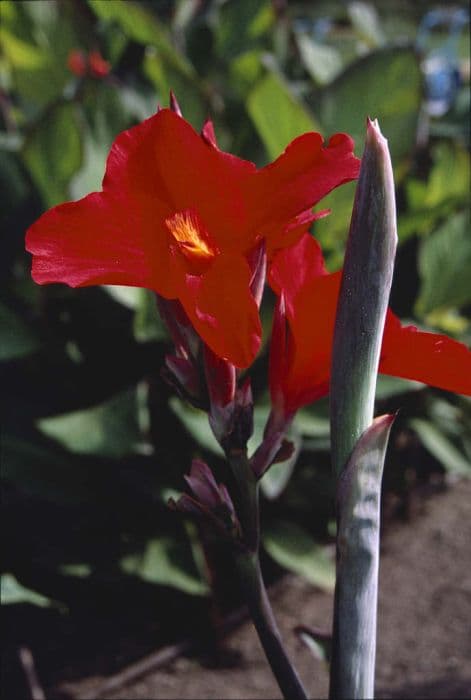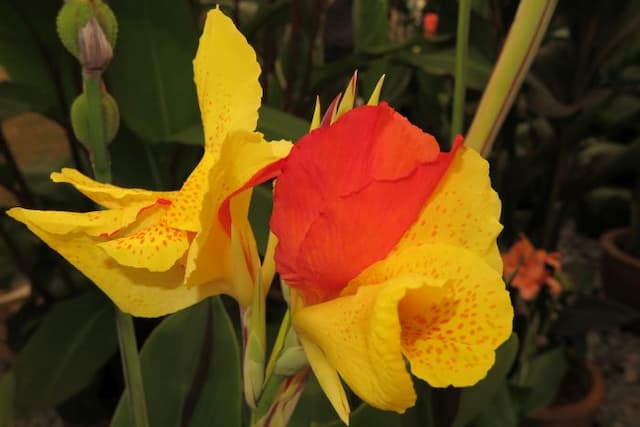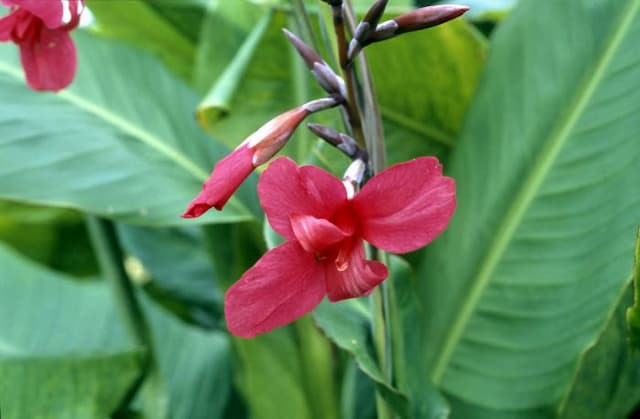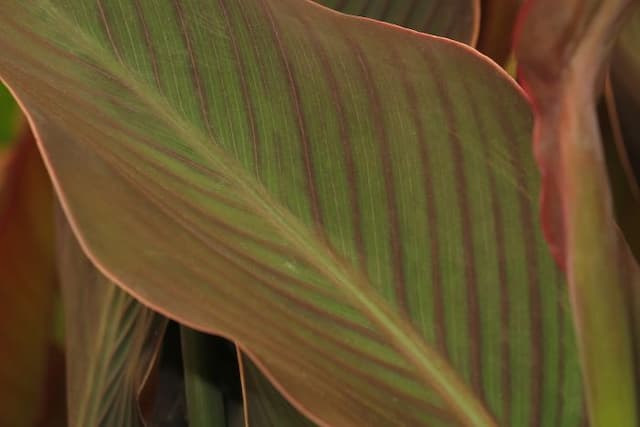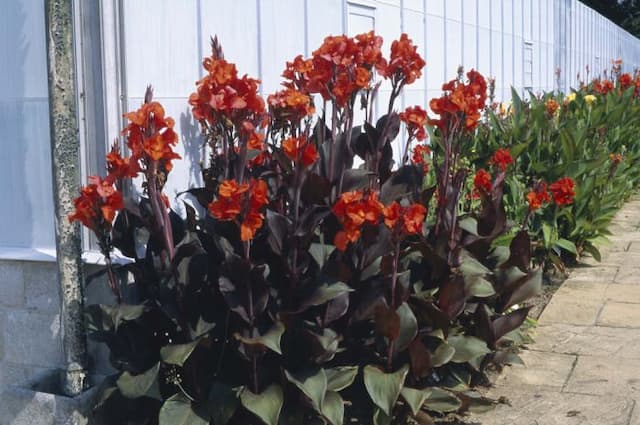Canna Lily Canna 'Ra'

ABOUT
Canna 'Ra' is a vibrant and showy plant known for its large, broad leaves that have a lush, tropical look. The foliage varies in color from deep green to bronze and maroon hues, producing a bold and dramatic effect in the garden. The leaves may also have a smooth, waxy finish or a slightly ribbed texture, adding to their visual appeal. Adding to its beauty, Canna 'Ra' displays striking flowers that emerge on tall stalks rising above the foliage. These blooms are large and resemble an iris or gladiolus in shape, often showcasing fiery shades of red, orange, or yellow, which sometimes blend together to create a sunset effect. The petals can have ruffled or smooth edges and are known for their showiness. The contrast between the flowers and the dark foliage allows Canna 'Ra' to serve as an eye-catching specimen in any landscape. This plant thrives in conditions with plenty of sunlight and moisture, making it a popular choice for gardeners looking to add a tropical flair to their outdoor spaces.
About this plant
 Names
NamesSynonyms
Canna Lily, Indian Shot, African Arrowroot, Sierra Leone Arrowroot
Common names
Canna 'Ra'
 Toxicity
ToxicityTo humans
The Canna 'Ra', commonly referred to as just Canna, is generally not considered toxic to humans. There are no significant toxic effects known for humans who ingest parts of this plant. However, as with any plant material, individual allergies or sensitivities could potentially cause mild stomach upset or dermatitis in rare cases.
To pets
The Canna 'Ra', or simply Canna, is not recognized as toxic to pets either. It is not known to cause any severe symptoms of poisoning in pets such as dogs or cats if they ingest parts of the plant. That being said, it's possible for pets to experience mild gastrointestinal discomfort if they consume large quantities, though this is not common and the Canna is generally considered safe for pets when it comes to toxicity.
 Characteristics
CharacteristicsLife cycle
Perennials
Foliage type
Deciduous
Color of leaves
Mixed
Flower color
Mixed
Height
5 feet (1.5 meters)
Spread
2 feet (0.6 meters)
Plant type
Bulb
Hardiness zones
Varies
Native area
Varies
Benefits
 General Benefits
General Benefits- Attractive Foliage: Canna 'Ra' has large, broad leaves that add a lush, tropical feel to any garden.
- Vibrant Blooms: It produces brilliant yellow flowers that can add a pop of color to landscaping.
- Fast Growth: This plant is known for its rapid growth, quickly filling in garden spaces.
- Low Maintenance: Canna 'Ra' is relatively easy to care for, requiring little attention once established.
- Drought Tolerance: It can withstand periods of low water, making it suitable for xeriscaping and drought-prone areas.
- Adapts to Various Soils: This plant can tolerate a range of soil types, though it prefers moist, well-draining conditions.
- Seasonal Impact: It offers a strong visual interest from spring to fall, with foliage persisting through multiple seasons.
- Height for Structure: Canna 'Ra' can grow to a substantial height, providing structure and depth to garden designs.
- Pest Resistance: The plant is relatively resistant to common garden pests, reducing the need for chemical treatments.
- Attracts Wildlife: Its flowers can attract pollinators like bees and butterflies, enhancing the biodiversity of the garden.
 Medical Properties
Medical PropertiesThis plant is not used for medical purposes.
 Air-purifying Qualities
Air-purifying QualitiesThis plant is not specifically known for air purifying qualities.
 Other Uses
Other Uses- Canna's fibrous stalks can be processed into paper. The stalks of Canna offer an alternative fiber source for paper production, reducing the reliance on traditional timber.
- The seeds of Canna can be used as beads in jewelry making. The hard, small, and round seeds are sometimes dried, drilled, and used in making necklaces and bracelets.
- As a biofuel crop. Canna's high biomass yield makes it a potential raw material for the production of bioethanol.
- In bioplastic production. Researchers are exploring the use of Canna starch in the production of biodegradable plastics.
- Canna rhizomes can be used for making alcohol. The starchy rhizomes may be fermented to produce a form of alcohol.
- In the crafting of musical instruments. Some cultures may use the stems or seeds of Canna in making musical instruments like shakers or rain sticks.
- As a natural dye source. The colorful leaves and flowers of Canna may be used to produce dyes for fabrics or art projects.
- Canna leaves can be used to wrap food for cooking, similar to banana leaves. This can impart a subtle flavor and maintain moisture while cooking.
- Used in water filtration systems. The roots of Canna plants can help to filter and clean water through phytoremediation in constructed wetlands.
- The fibers from Canna stalks can be woven into textiles or mats, offering an alternative material for artisanal crafts.
Interesting Facts
 Feng Shui
Feng ShuiThe Canna Lily is not used in Feng Shui practice.
 Zodiac Sign Compitability
Zodiac Sign CompitabilityThe Canna Lily is not used in astrology practice.
 Plant Symbolism
Plant Symbolism- Tropical Vibrance: The Canna 'Ra' symbolizes exotic beauty and vibrancy due to its bright, flamboyant flowers and lush foliage, reflecting the rich and energetic aspects of tropical regions.
- Confidence and Pride: Its bold presence and height, which can make it a focal point in gardens, represent confidence and pride, inspiring individuals to stand tall and embrace their own uniqueness.
- Transformation: Can be a symbol of change and transformation as it dies back in winter only to regrow with renewed vitality in the spring, paralleling the cycle of growth and renewal in our own lives.
- Prosperity and Wealth: In some cultures, the Canna 'Ra', with its showy flowers, is associated with prosperity and wealth, as it is thought to attract abundance and success.
 Water
WaterCanna Lilies should be watered to keep the soil consistently moist, but not soggy. During the growing season, they may require watering multiple times a week, especially if the weather is particularly hot or dry. Generally, aim for about 1 to 2 inches of water per week, whether from rainfall or irrigation. In container cultivation, water when the top inch of soil feels dry to the touch. It’s best to water in the morning to allow moisture on the foliage to dry out over the day, reducing the risk of fungal diseases.
 Light
LightCanna Lilies thrive in full sun with at least six hours of direct sunlight daily. The ideal spot for these plants is an area that receives ample morning sun and some afternoon shade, particularly in hotter regions to prevent scorching. They can tolerate partial shade but will have reduced flowering. Ensure to position them away from taller plants that might overshadow them and reduce their light exposure.
 Temperature
TemperatureCanna Lilies prefer warm temperatures and do best when the temperature ranges between 60°F and 90°F. They can survive minimum temperatures of approximately 55°F, but prolonged exposure to cold can damage them. Make sure to plant them after the danger of frost has passed, and if in a pot, move them indoors before fall frosts.
 Pruning
PruningCanna Lilies require minimal pruning. Dead or damaged foliage should be removed to maintain plant aesthetics and health. After the first frost, cut the plants back to a few inches above the ground to prepare for winter. Pruning is also necessary when cutting back spent flower stalks to encourage additional blooms. The best time for pruning is in the late fall or early spring before new growth emerges.
 Cleaning
CleaningAs needed
 Soil
SoilThe best soil mix for Canna Lily 'Ra' is rich, well-draining soil with added compost or manure. Aim for a soil pH between 6.0 and 6.5, which is slightly acidic to neutral.
 Repotting
RepottingCanna Lily 'Ra' should be repotted every 2 to 3 years or when it outgrows its container to ensure adequate space for root growth.
 Humidity & Misting
Humidity & MistingCanna Lily 'Ra' thrives best at high humidity levels, ideally between 60% and 70%.
 Suitable locations
Suitable locationsIndoor
Provide bright light and keep soil moist for indoor Canna Lily 'Ra'.
Outdoor
Plant in full sun, rich soil, and water regularly for outdoor Canna Lily 'Ra'.
Hardiness zone
7-11 USDA
 Life cycle
Life cycleCanna 'Ra', commonly known as Canna Lily, begins its life cycle when a rhizome is planted in the soil during late winter to spring. The rhizome sprouts to produce shoots, which then develop into stems and leaves. As the plant matures, it develops vibrant flowers during the summer months, attracting pollinators with its bright colors and distinctive shape. After flowering, the plant may produce seeds, although many cultivars are sterile and do not set viable seeds. In the autumn, as temperatures drop, the Canna Lily enters a period of dormancy where the aerial parts of the plant die back, and the rhizome remains dormant in the soil. The following growing season, the rhizome resumes growth, completing the cycle and beginning a new year of growth and flowering.
 Propogation
PropogationPropogation time
Spring-Early Summer
The Canna 'Ra', also known as Canna Lily, is commonly propagated through division, which is best done in the spring before new growth starts. To propagate Canna Lily by division, carefully dig up the rhizomes after the plant has stopped flowering and the foliage has died back. Wash the soil off the rhizomes and use a sharp, clean knife to cut them into sections, ensuring that each section has at least one eye, or growth point. These sections can then be planted about 3 to 4 inches (7.6 to 10.2 cm) deep in well-draining soil, spaced 1 to 2 feet (30.5 to 61 cm) apart to allow for growth. Water the newly planted rhizomes thoroughly and expect new shoots to emerge after a few weeks.

